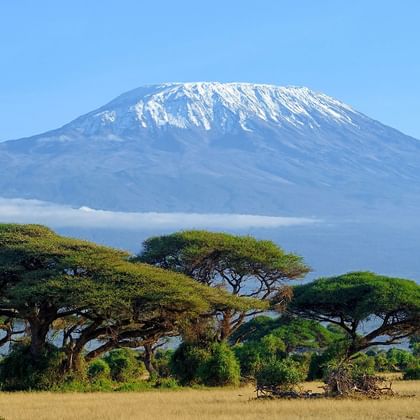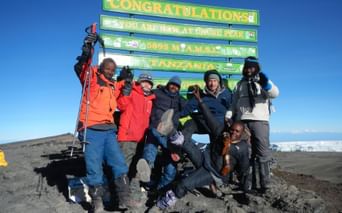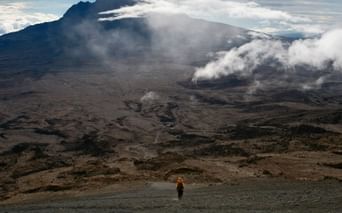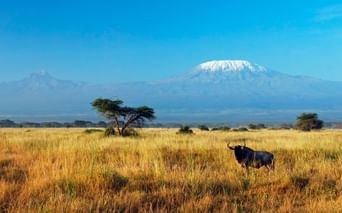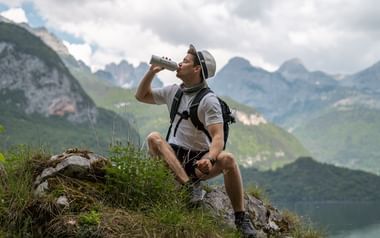Itinerary
Arrival at Mountain Inn Hotel in Moshi. The hotel is located on the outskirts of town at the foot of Kilimanjaro. The rest of the day is at your leisure. You can explore Moshi on your own and perhaps visit the town’s bustling market. After dinner, there will be a briefing about the upcoming days and the ascent of Kilimanjaro.
After breakfast, you’ll be picked up from your hotel and driven to the entrance of Kilimanjaro National Park at Machame Gate. Here, you’ll meet your local team, who will accompany you throughout the week. Your luggage will be organised, and park entry formalities will be completed. It’s impressive to see just how much gear needs to be brought up the mountain – and not least how it all gets carried there.
Once everything is packed and ready, your Kilimanjaro adventure begins. Soon, you’ll find yourselves surrounded by the lush rainforest, with ancient trees, giant ferns, vines, lichen, and moss carpeting the forest floor and hanging like curtains from the trees. In the treetops, black-and-white colobus monkeys play and move about. The day’s goal is Machame Camp, located at 3,010 metres, just above the tree line.
After leaving Machame Camp, the trail becomes steeper, and the landscape changes to more alpine terrain, where the vegetation consists mainly of shrubs. As you reach the open moorland, a magnificent view of the Shira Ridge and Kibo Massif unfolds before you. You’ll stop for lunch at “Picnic Rock.”
Today’s hike is a bit shorter than yesterday’s, and by mid-afternoon you’ll arrive at the camp on the Shira Plateau. From here, you’ll enjoy breathtaking views of the mountain, and at sunset, the warm evening light beautifully illuminates Kibo’s cliffs and glaciers.
Today’s stage is designed with acclimatisation in mind. You’ll start with a long ascent from Shira Camp towards Lava Tower Hut. As you climb higher, the vegetation becomes increasingly sparse as you enter the afro-alpine desert zone. You’ll hike through the surreal landscape of the Barranco Valley before stopping for food, rest, and overnight at Barranco Camp.
Today is set aside for an excursion to the Karanga Valley. After breakfast, you’ll leave the camp, and after about an hour’s hike, you’ll reach the base of the impressive Barranco Wall. At first glance, it looks steep and almost impossible to climb, but a well-defined trail winds all the way to the top. After a couple of hours of steady ascent, you’ll reach the summit and be rewarded with a magnificent view over the vast plateau and the valley where Karanga Camp (4,200 m) is located. You’ll have your packed lunch here before returning to Barranco Camp for rest and overnight.
Today’s trek begins with the ascent of the Barranco Wall, which you’ll already be familiar with from yesterday’s hike. After reaching the top, the trail continues up and down along the ridgeline and across the plateau. In the Karanga Valley, you’ll stop for lunch before beginning the 2–3 hour climb to Barafu Camp (4,640 m). The camp sits in open and exposed terrain, and when the wind picks up, it can feel quite cold.
You’ll arrive early in the afternoon, giving you plenty of time to rest and perhaps take a short acclimatisation hike nearby. From here, you’ll have stunning views of one of Kilimanjaro’s distinctive peaks, Mawenzi (5,149 m), as well as the route leading toward Stella Point. Dinner will be served early in the evening, and afterwards, it’s all about getting as much rest as possible before the big challenge ahead – the night ascent to the summit.
After some hot tea and a light snack, the ascent begins around midnight. You’ll set out into the darkness, guided only by your headlamps – and if you’re lucky, by the glow of the full moon. After 6–7 hours of strenuous trekking, where the altitude can really be felt, you’ll reach Stella Point on the crater rim of Kilimanjaro. From here, it’s another 1–2 hours of climbing along the rim, with an unforgettable view, before you finally stand on Uhuru Peak, 5,895 metres – the very top of Africa.
From the summit, Kilimanjaro reveals its full splendour: glaciers and ice fields close at hand, and the endless landscape far below, bathed in the first rays of sunrise. It’s a truly powerful moment – and of course, the obligatory photos by the famous sign will capture this golden memory in the soft morning light.
The descent follows roughly the same route back to Barafu Camp, where you’ll arrive shortly before midday and be greeted by the rest of the team with a well-deserved hot meal. After a few hours of rest, you’ll continue down to Mweka Camp, where dinner and a good night’s sleep await.
The final stretch of your African mountain adventure begins after breakfast with the mountain guides’ traditional farewell ceremony – a warm and festive experience you won’t soon forget. Afterwards, you’ll enjoy a gentle 2–3 hour descent through lush rainforest before reaching Mweka Gate. From here, you’ll be driven back to the Mountain Inn Hotel in Moshi.
The rest of the day is yours to unwind – loosen up sore muscles in the hotel pool, enjoy some well-deserved relaxation, and reflect on the many incredible experiences of the past days. Or perhaps head out to explore Moshi and do some last-minute shopping before your onward journey.
Departure from Mountain Inn Hotel in Moshi. You’ll be transferred to the airport in time for your flight home.
Photos from the tour
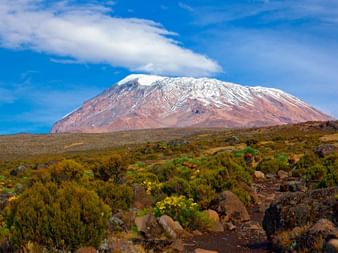
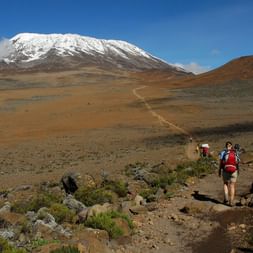
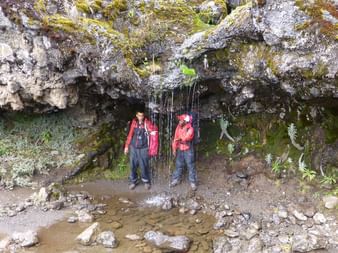
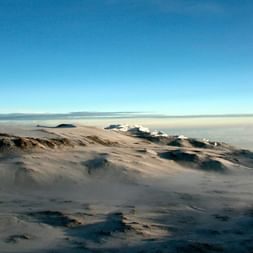
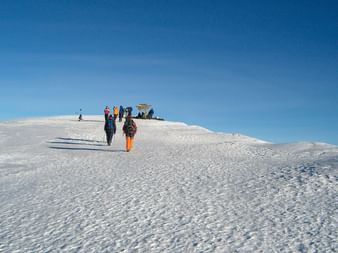
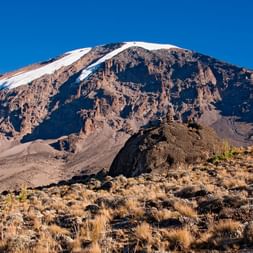
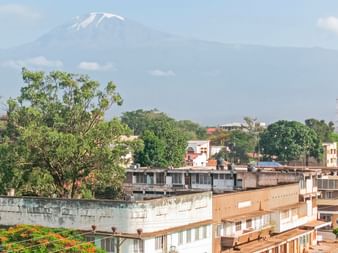
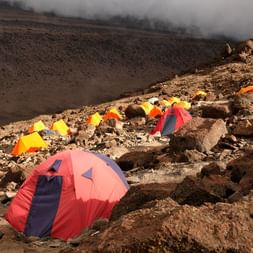
Prices and dates
The price includes
- 7-day Kilimanjaro climb via the Machame Route as per the program
- 2 nights’ accommodation at a hotel in Moshi, including breakfast and dinner
- Round-trip transport from the hotel to the national park entrance
- Camping equipment with quality two-person tents
- Shared dining tent with tables and chairs
- All meals during the climb, as well as drinking water on the trek
- Professional, KINAPA-certified, English-speaking local guide
- KINAPA-certified porters for luggage transport and kitchen team (bags must not exceed 12 kg)
- Climbing permit for Kilimanjaro
- Entrance fee to the National Park
- Kilimanjaro Rescue Fee
- Luggage storage at the hotel during the climb
- 1x oxygen cylinder per group (for emergencies)
- 24-hour local and international service hotline for the duration of the tour
- All taxes and fees
- This is a packaged holiday and is therefore covered by The Travel Guarantee Fund - See which benefits this means for you - click here
- Transportation to/from the destination
- Visa for Tanzania
- Lunches during your stay in Moshi
- Tips for guide and porters (approximately 80 USD per participant)
- Travel insurance
- Handling fee (€25)
Practical Information
The price is based upon two people sharing. It is also possible travel alone in a single room. Simply choose "1 person" in the booking form and it will automatically add the single room surcharge.
On this tour you will be on your own supplied with maps, route descriptions and luggage transfers. That means that your time is your own and you have plenty of time to enjoy the stages in your own pace.
Check the price quickly
You can quickly check the price of your desired trip without having to fill out any forms. Here’s how:
- Click on the "Calculate Price" button (you’ll find it in the "Dates and Prices" section) – this will take you to the first pages of the booking form
- Select your preferred date, number of people, room distribution, any extra nights, and any available add-ons you may want
- See the price
Get a quote
If you would like a flight included, or changes made to the trip, you can request a customized offer by clicking the "Get Quote" button at the top of the page. Remember to describe in detail what changes you would like.
The booking process
When you book the trip, we will begin booking hotels and arranging all the practical aspects of your tour. This process typically takes 5–8 working days, but in some cases it may take longer for certain bookings. If you arrange your own transportation, we recommend waiting until we have confirmed your booking before making any arrangements.
Dates
If you can select a date in the trip calendar (in the booking form), then this is a possible start date. We regularly update our trips with sold-out dates; these dates will then appear in red/grey and cannot be selected.
Flights to Tanzania are not included in the price of the trip. We recommend that you find the flights yourself, for example via www.momondo.com.
We recommend that you wait to arrange your transport until we have confirmed your trip.
Here's how it works:
- You book your journey with us
- We confirm your journey (usually within 5-8 business days)
- You arrange your transport
Get a quote
If you need us to organise your flight for you, you can request a quote for the trip including flights. It often takes about two days to get a quote. Please note that we charge a handling fee of DKK 350 per ticket, which means that you get the flight cheaper by booking it yourself.
Airport transfers
Transfers from/to the airport are included in the price and you'll be picked up no matter what time of day you arrive.
In Moshi, you will stay at Mountain Inn Hotel, a small and charming family-run hotel located on the outskirts of Moshi, at the foot of Kilimanjaro. On Kilimanjaro itself, you will overnight in comfortable two-person tents. We provide a shared dining tent with tables and chairs, as well as a toilet tent.
Note: It is also possible to book single rooms/tents on the trip. This can be selected in the booking form.
During your stay in Moshi, breakfast and dinner are included, but you will need to buy your own lunch. On Kilimanjaro, all meals are included. A cook and kitchen team accompany the trip, preparing breakfast and dinner, which are served in the camp. Lunch is packed and eaten along the way. The kitchen team also provides drinking water, tea, and coffee.
A typical day on Kilimanjaro begins with a wake-up call between 6:00 and 6:30 am. Once you are dressed and have had breakfast, you pack your bags and start walking around 8:00 am. It is important to go at your own pace and take the breaks you need. Around 11:30–12:00, you will have a nice long lunch break and eat the packed meal before continuing with the afternoon hike. You will reach the campsite during the afternoon, with plenty of time to relax. Dinner is served between 6:00 and 7:00 pm, and most people choose to go to bed early.
To get the best experience and the greatest benefit from the trek up Kilimanjaro, it is a big advantage to be in good physical shape and to have trained beforehand. It is difficult to do mountain hikes at home, but any kind of exercise that raises your heart rate is good preparation. This could be running, cycling, spinning, or other workouts. It is also highly recommended to go on some long walks. This is also a great opportunity to properly break in your footwear.
Kilimanjaro is not a technically difficult mountain, but the altitude and thin air affect the body’s performance. How quickly the body adapts to altitude varies greatly from person to person, but the trek is designed with proper acclimatization in mind for all participants.
The Kilimanjaro trek is graded level 4. The first days up the mountain are level 3, but summit day is experienced by many participants as long and tough, which is why we have graded it as level 4. The trek up Kilimanjaro is demanding hiking with daily stages of 6–8 hours, sometimes in challenging terrain. There will be long ascents, and the trek requires good physical condition and endurance. You can read more about our grading system here.
Proper acclimatization and adjustment to the altitude are absolutely crucial for success on Kilimanjaro. Some tour operators offer 4- or 5-day treks on the mountain, and we strongly advise against this. Acclimatization takes time, and on this trip we use 5 days to reach the summit and a total of 6 days on the mountain.
As an important part of the acclimatization process, we have included an extra day at Horombo at 3,700 meters, which we use to hike up to 4,400 meters and back again, before overnighting in Horombo. “Climb high, sleep low” is the optimal way to help the body adjust to altitude. The more time you spend on the ascent, the better you will feel, and the easier it will be to reach the summit. The best way to prevent altitude sickness is to walk slowly and drink plenty of water.
Most climbers on Kilimanjaro will experience mild symptoms of altitude sickness such as headaches, loss of appetite, and sleeplessness, but these usually pass quickly. If you experience more severe symptoms such as intense headaches, dizziness, vomiting, and extreme fatigue, it is important to seek help and descend as quickly as possible – even if it is in the middle of the night. Contact your guide immediately if you experience symptoms of altitude sickness.
Day 2: Machame Camp, 3,010 m
Day 3: Shira Camp, 3,875 m
Day 4: Barranco Camp, 3,960 m
Day 5: Karanga Camp, 4,200 m
Day 6: Barafu Camp, 4,640 m
Day 7: Uhuru Peak, 5,895 m – down to Mweka Camp, 3,080 m
Day 8: Descent to Mweka Gate, 1,630 m
We recommend taking out travel insurance that covers at least illness, accident, repatriation, lost holiday, luggage and liability. As a customer, you are responsible for taking out the necessary travel insurance to cover these costs.
Before taking out insurance, you should check whether you are already covered by travel or cancellation insurance through your home insurance company, credit card or similar - please note that there may be differences in insurance coverage.
After booking this trip, you get access to various discount schemes.
Kilimanjaro can be climbed year-round, but we schedule our trips during the times when the weather is traditionally at its best.
From April to May, it is the rainy season with heavy clouds and a lot of rainfall. January to March is an excellent period with clear skies and mild temperatures. From June to August it is colder, but the weather is very clear. In September and October it gets warmer again, often with fog at the lower parts of the mountain, but usually beautiful weather above 3,000 meters. November and December generally bring clear skies, with the occasional rain shower.
Kilimanjaro, 5,896 m, is Africa’s highest mountain and the world’s highest free-standing mountain. It is also the 4th highest mountain of “The Seven Summits,” which are the tallest peaks on the 7 continents. Kilimanjaro is a dormant cone volcano and covers an area about the size of Funen. The part of the mountain that lies above 2,700 meters is designated as a national park. Kilimanjaro is listed as a UNESCO World Heritage Site.
Routes on Kilimanjaro
There are 6 traditional routes to the summit of Kilimanjaro: Marangu (the Cola route), Machame, Rongai, Lemosho, Shira, and Umbwe. In addition, there are a few other routes that are rarely used. Each route has its own characteristics, with different levels of difficulty and unique natural experiences. The Machame route is one of the most beautiful and varied routes on Kilimanjaro. The ascent follows a more natural rather than man-made path towards the Roof of Africa. To achieve the best possible altitude acclimatization, we have planned the trip with a full 7 days on the mountain, which provides much better adaptation to the altitude. This greatly reduces the risk of altitude sickness and increases the chance of reaching the summit. Along the way, we overnight in good 2-person tents, and we bring a large dining tent. A local cook joins us on the expedition to take care of the meals.

"We look forward to making your holiday dreams come true"
